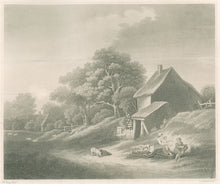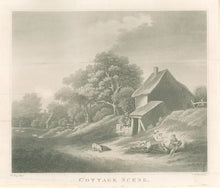After a landscape by William Redmore Bigg. “Cottage Scene”
From The Port Folio. Philadelphia, 1810. 9 1/2 x 11 1/2 (image) plus margins. Stipple engraving by C[ornelius] Tiebout. With folds as originally issued. Repaired tear into image at bottom. Conserved. Backed for strength and to flatten an old horizontal bend near the tree top. Stauffer, 3207.
Cornelius Tiebout (1773-1832) had a little known but fascinating career as an engraver in the early American republic. His earliest work was done in New York City in 1789 when he learned engraving from a silversmith. In the first decade of the new nation he produced patriotic prints, and in 1793 he traveled to London where he studied under James Heath and learned stipple engraving. Having participated in the London art community, he returned to New York in 1796 where he worked for three years, then moved to Philadelphia where he was active and influential for at least twenty five years. In 1825 he and his daughter Caroline moved to New Harmony, Indiana where they produced beautiful natural history prints for Thomas Say’s volumes illustrating insects and shells.
This depiction of a British cottage scene after a painting by the English artist William Redmore Bigg (1755-1828) shows Tiebout at his artistic best as he raised his work above bank note engraving. This print is an unusually large illustration in The Port Folio and there was no accompanying article about the print in the publication. The original painting by Bigg is either lost or privately owned. However, a series of three prints, "Three Views of Cottages near Colchester", after by W. R. Bigg, were known to have been engraved in England.





